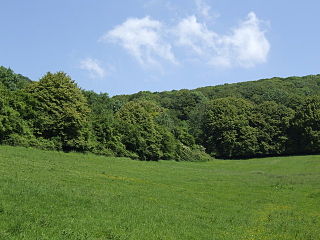
Aricia agestis, the brown argus, is a butterfly in the family Lycaenidae. It is found throughout the Palearctic realm, north to northern Jutland (Denmark) and east to Siberia and the Tian Shan.

The northern brown argus is a butterfly in the family Lycaenidae. It is found throughout much of the Palearctic realm.

Axbridge Hill and Fry's Hill is a 64.8-hectare (160-acre) biological Site of Special Scientific Interest in the Mendip Hills, Somerset, notified in 1990. The hills are above the town of Axbridge, immediately to the east of Shute Shelve Hill.

Cheddar Wood is an 86.9-hectare (215-acre) biological Site of Special Scientific Interest at Cheddar in the Mendip Hills, Somerset, England, notified in 1967.

Rodney Stoke is a 69.6 hectare biological Site of Special Scientific Interest, just north of the village of Rodney Stoke in the Mendip Hills, Somerset, notified in 1957.

Twinhills Woods and Meadows is a 21.2 hectare biological Site of Special Scientific Interest on the Monarch's Way south of Dulcote in Somerset, notified in 1990.

The Tottenham Marshes are located at Tottenham in the London Borough of Haringey. The marshes cover over 100 acres (0.40 km2) and became part of the Lee Valley Park in 1972. The marsh is made up of three main areas: Clendish Marsh, Wild Marsh West and Wild Marsh East. The latter two are separated by the River Lea.

Aricia nicias, the silvery argus, is a butterfly of the family Lycaenidae. It is found in the Alps, Pyrenees and from Scandinavia ranging to Siberia and the north of Mongolia.

Aricia morronensis, the Spanish argus, is a butterfly of the family Lycaenidae. It is found in Spain and Hautes-Pyrénées (France).

Aricia anteros, the blue argus, is a European butterfly in the family Lycaenidae. It has a wingspan of 30–34 mm. In Europe it can be found in Macedonia, Albania, Greece, Bulgaria, Serbia, Croatia, Montenegro, Bosnia and Herzegovina, Romania, Ukraine and in Turkey. Its primary larval food plants are Geranium sanguineum and Geranium macrorrhizum.

Watts Bank is a 1.9-hectare (4.7-acre) nature reserve south of Lambourn in Berkshire. It is managed by the Berkshire, Buckinghamshire and Oxfordshire Wildlife Trust. It is designated a biological Site of Special Scientific Interest as White Shute.











